1. Dube SR, Felitti VJ, Dong M, Chapman DP, Giles WH, Anda RF. Childhood abuse, neglect, and household dysfunction and the risk of illicit drug use: the adverse childhood experiences study. Pediatrics. 2003; 111(3):564–572. PMID:
12612237.

2. Finkelhor D. Screening for adverse childhood experiences (ACEs): Cautions and suggestions. Child Abuse Negl. 2018; 85:174–179. PMID:
28784309.

3. Denholm R, Power C, Li L. Adverse childhood experiences and child-to-adult height trajectories in the 1958 British birth cohort. Int J Epidemiol. 2013; 42(5):1399–1409. PMID:
24019423.

4. Danese A, Moffitt TE, Harrington H, Milne BJ, Polanczyk G, Pariante CM, et al. Adverse childhood experiences and adult risk factors for age-related disease: depression, inflammation, and clustering of metabolic risk markers. Arch Pediatr Adolesc Med. 2009; 163(12):1135–1143. PMID:
19996051.

5. Green JG, McLaughlin KA, Berglund PA, Gruber MJ, Sampson NA, Zaslavsky AM, et al. Childhood adversities and adult psychiatric disorders in the national comorbidity survey replication I: associations with first onset of DSM-IV disorders. Arch Gen Psychiatry. 2010; 67(2):113–123. PMID:
20124111.
6. Bethell CD, Carle A, Hudziak J, Gombojav N, Powers K, Wade R, et al. Methods to assess adverse childhood experiences of children and families: toward approaches to promote child well-being in policy and practice. Acad Pediatr. 2017; 17(7 Suppl):S51–S69. PMID:
28865661.

7. Kenney MK, Singh GK. Adverse childhood experiences among American Indian/Alaska native children: the 2011–2012 national survey of children's health. Scientifica (Cairo). 2016; 2016:7424239. PMID:
27529052.

8. Brown DW, Anda RF. Adverse childhood experiences: origins of behaviors that sustain the HIV epidemic. AIDS. 2009; 23(16):2231–2233.

9. Duke NN, Pettingell SL, McMorris BJ, Borowsky IW. Adolescent violence perpetration: associations with multiple types of adverse childhood experiences. Pediatrics. 2010; 125(4):e778–e786. PMID:
20231180.

10. Brown DW, Anda RF, Edwards VJ, Felitti VJ, Dube SR, Giles WH. Adverse childhood experiences and childhood autobiographical memory disturbance. Child Abuse Negl. 2007; 31(9):961–969. PMID:
17868865.

11. Romens SE, McDonald J, Svaren J, Pollak SD. Associations between early life stress and gene methylation in children. Child Dev. 2015; 86(1):303–309. PMID:
25056599.

12. Flaherty EG, Thompson R, Litrownik AJ, Theodore A, English DJ, Black MM, et al. Effect of early childhood adversity on child health. Arch Pediatr Adolesc Med. 2006; 160(12):1232–1238. PMID:
17146020.

13. Anda RF, Felitti VJ, Bremner JD, Walker JD, Whitfield C, Perry BD, et al. The enduring effects of abuse and related adverse experiences in childhood. A convergence of evidence from neurobiology and epidemiology. Eur Arch Psychiatry Clin Neurosci. 2006; 256(3):174–186. PMID:
16311898.
14. Slavich GM, Cole SW. The emerging field of human social genomics. Clin Psychol Sci. 2013; 1(3):331–348. PMID:
23853742.

15. Loman MM, Gunnar MR. Early Experience, Stress, and Neurobehavioral Development Center. Early experience and the development of stress reactivity and regulation in children. Neurosci Biobehav Rev. 2010; 34(6):867–876. PMID:
19481109.

16. Rahman A, Perri A, Deegan A, Kuntz J, Cawthorpe D. On becoming trauma-informed: role of the adverse childhood experiences survey in tertiary child and adolescent mental health services and the association with standard measures of impairment and severity. Perm J. 2018; 22:17–054.

17. Balistreri KS, Alvira-Hammond M. Adverse childhood experiences, family functioning and adolescent health and emotional well-being. Public Health. 2016; 132:72–78. PMID:
26718424.

18. Smith MV, Gotman N, Yonkers KA. Early childhood adversity and pregnancy outcomes. Matern Child Health J. 2016; 20(4):790–798. PMID:
26762511.

19. Merrick MT, Ports KA, Ford DC, Afifi TO, Gershoff ET, Grogan-Kaylor A. Unpacking the impact of adverse childhood experiences on adult mental health. Child Abuse Negl. 2017; 69:10–19. PMID:
28419887.

20. Almuneef M, ElChoueiry N, Saleheen HN, Al-Eissa M. Gender-based disparities in the impact of adverse childhood experiences on adult health: findings from a national study in the Kingdom of Saudi Arabia. Int J Equity Health. 2017; 16(1):90. PMID:
28558774.

21. Lê-Scherban F, Wang X, Boyle-Steed KH, Pachter LM. Intergenerational associations of parent adverse childhood experiences and child health outcomes. Pediatrics. 2018; 141(6):e20174274. PMID:
29784755.

22. Randell KA, O'Malley D, Dowd MD. Association of parental adverse childhood experiences and current child adversity. JAMA Pediatr. 2015; 169(8):786–787. PMID:
26030177.

23. Burke NJ, Hellman JL, Scott BG, Weems CF, Carrion VG. The impact of adverse childhood experiences on an urban pediatric population. Child Abuse Negl. 2011; 35(6):408–413. PMID:
21652073.

24. Lee MS, Kim HS, Park EJ, Bhang SY. Efficacy of the ‘Children in Disaster: Evaluation and Recovery (CIDER)’ protocol for traumatized adolescents in Korea. J Korean Med Sci. 2020; 35(29):e240. PMID:
32715670.

25. Oh JK, Yoon JY, Lee CS, Choi JW, Bhang SY, Kweon YS. The Effectiveness of the SBIRT intervention on the high-risk group of students for the internet-smartphone addiction in the community. J Korean Academy of Addiction Psychiatry. 2018; 22(2):113–120.

26. Balistreri KS. Adverse childhood experiences, the medical home, and child well-being. Matern Child Health J. 2015; 19(11):2492–2500. PMID:
26140833.

28. Cheong EV, Sinnott C, Dahly D, Kearney PM. Adverse childhood experiences (ACEs) and later-life depression: perceived social support as a potential protective factor. BMJ Open. 2017; 7(9):e013228.

29. Lance CE, Butts MM, Michels LC. The sources of four commonly reported cutoff criteria: what did they really say? Organ Res Methods. 2006; 9(2):202–220.
30. National Youth Policy Institute. A Study on Mental Health Improvement Policy for Children and Adolescents: Statistics. Seoul: National Youth Policy Institute;2011.
31. Pearson K. On the criterion that a given system of deviations from the probable in the case of a correlated system of variables is such that it can be reasonably supposed to have arisen from random sampling. Philos Mag J Sci. 1900; 50(302):157–175.

33. Read J, Fraser A. Abuse histories of psychiatric inpatients: to ask or not to ask? Psychiatr Serv. 1998; 49(3):355–359. PMID:
9525796.

34. Adams ZW, Moreland A, Cohen JR, Lee RC, Hanson RF, Danielson CK, et al. Polyvictimization: latent profiles and mental health outcomes in a clinical sample of adolescents. Psychol Violence. 2016; 6(1):145–155. PMID:
26958417.

35. Grilo CM, Sanislow C, Fehon DC, Martino S, McGlashan TH. Psychological and behavioral functioning in adolescent psychiatric inpatients who report histories of childhood abuse. Am J Psychiatry. 1999; 156(4):538–543. PMID:
10200731.
36. Jimenez ME, Wade R Jr, Schwartz-Soicher O, Lin Y, Reichman NE. Adverse childhood experiences and ADHD diagnosis at age 9 years in a national urban sample. Acad Pediatr. 2017; 17(4):356–361. PMID:
28003143.

37. Clements-Nolle K, Waddington R. Adverse childhood experiences and psychological distress in juvenile offenders: the protective influence of resilience and youth assets. J Adolesc Health. 2019; 64(1):49–55. PMID:
30579436.

38. Baiden P, Stewart SL, Fallon B. The role of adverse childhood experiences as determinants of non-suicidal self-injury among children and adolescents referred to community and inpatient mental health settings. Child Abuse Negl. 2017; 69:163–176. PMID:
28477476.

39. Houtepen LC, Heron J, Suderman MJ, Fraser A, Chittleborough CR, Howe LD. Associations of adverse childhood experiences with educational attainment and adolescent health and the role of family and socioeconomic factors: a prospective cohort study in the UK. PLoS Med. 2020; 17(3):e1003031. PMID:
32119668.

40. Blum RW, Li M, Naranjo-Rivera G. Measuring adverse child experiences among young adolescents globally: relationships with depressive symptoms and violence perpetration. J Adolesc Health. 2019; 65(1):86–93. PMID:
30930089.

41. Schilling EA, Aseltine RH Jr, Gore S. Adverse childhood experiences and mental health in young adults: a longitudinal survey. BMC Public Health. 2007; 7(1):30. PMID:
17343754.

42. Anda RF, Croft JB, Felitti VJ, Nordenberg D, Giles WH, Williamson DF, et al. Adverse childhood experiences and smoking during adolescence and adulthood. JAMA. 1999; 282(17):1652–1658. PMID:
10553792.

43. Lee RD, Chen J. Adverse childhood experiences, mental health, and excessive alcohol use: Examination of race/ethnicity and sex differences. Child Abuse Negl. 2017; 69:40–48. PMID:
28448813.

44. de Araújo RM, Lara DR. More than words: The association of childhood emotional abuse and suicidal behavior. Eur Psychiatry. 2016; 37:14–21. PMID:
27442978.

45. van Duin L, Bevaart F, Zijlmans J, Luijks MA, Doreleijers TA, Wierdsma AI, et al. The role of adverse childhood experiences and mental health care use in psychological dysfunction of male multi-problem young adults. Eur Child Adolesc Psychiatry. 2019; 28(8):1065–1078. PMID:
30552585.

46. Boyce WT. The lifelong effects of early childhood adversity and toxic stress. Pediatr Dent. 2014; 36(2):102–108. PMID:
24717746.
47. Kerker BD, Zhang J, Nadeem E, Stein RE, Hurlburt MS, Heneghan A, et al. Adverse childhood experiences and mental health, chronic medical conditions, and development in young children. Acad Pediatr. 2015; 15(5):510–517. PMID:
26183001.

48. Karatekin C, Ahluwalia R. Effects of adverse childhood experiences, stress, and social support on the health of college students. J Interpers Violence. 2020; 35(1-2):150–172. PMID:
27920360.

49. Nurius PS, Green S, Logan-Greene P, Borja S. Life course pathways of adverse childhood experiences toward adult psychological well-being: a stress process analysis. Child Abuse Negl. 2015; 45:143–153. PMID:
25846195.

50. Warne D, Dulacki K, Spurlock M, Meath T, Davis MM, Wright B, et al. Adverse childhood experiences (ACE) among American Indians in South Dakota and associations with mental health conditions, alcohol use, and smoking. J Health Care Poor Underserved. 2017; 28(4):1559–1577. PMID:
29176114.

51. Felitti VJ, Anda RF, Nordenberg D, Williamson DF, Spitz AM, Edwards V, et al. Relationship of childhood abuse and household dysfunction to many of the leading causes of death in adults. The adverse childhood experiences (ACE) study. Am J Prev Med. 1998; 14(4):245–258. PMID:
9635069.
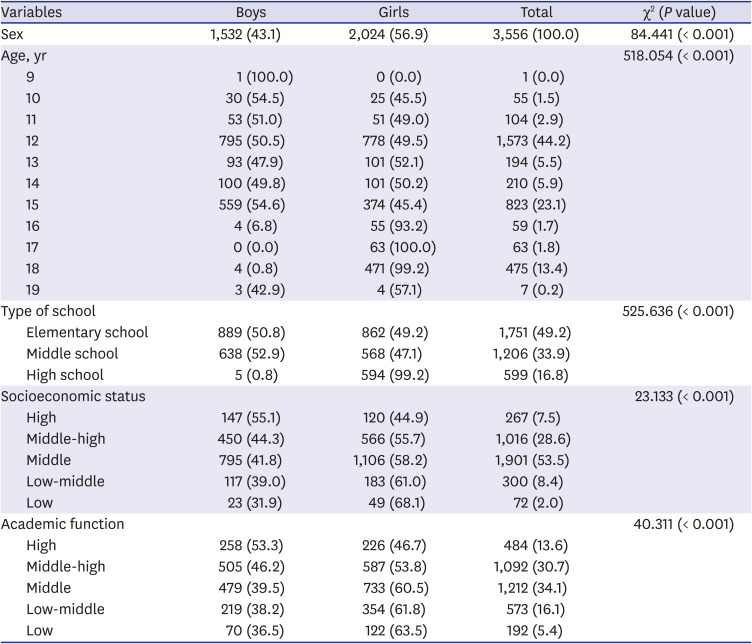
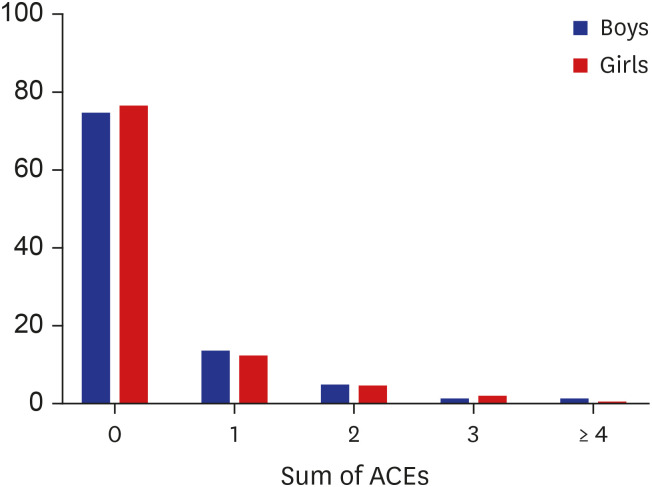

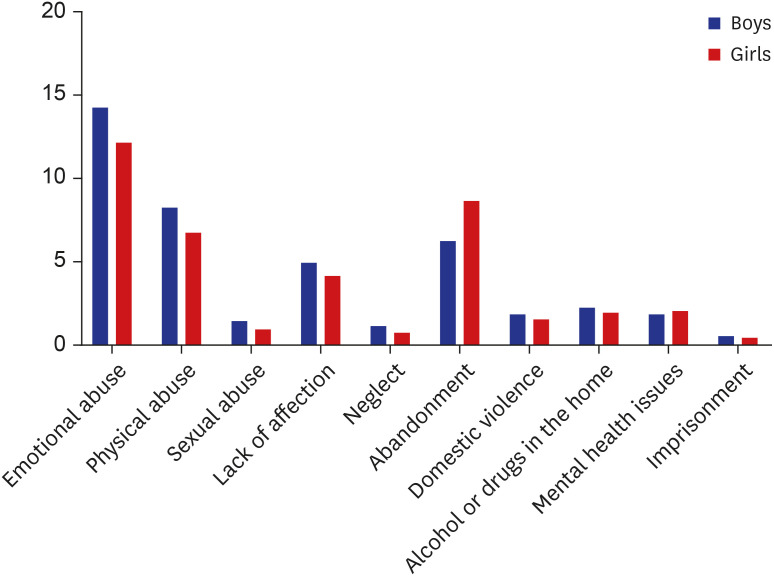
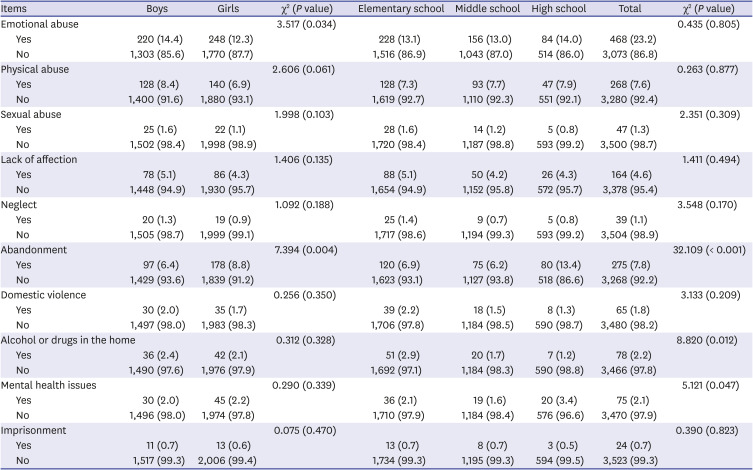




 PDF
PDF Citation
Citation Print
Print



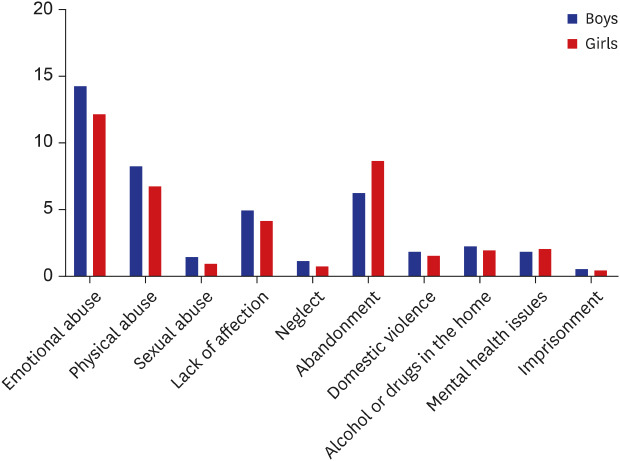
 XML Download
XML Download